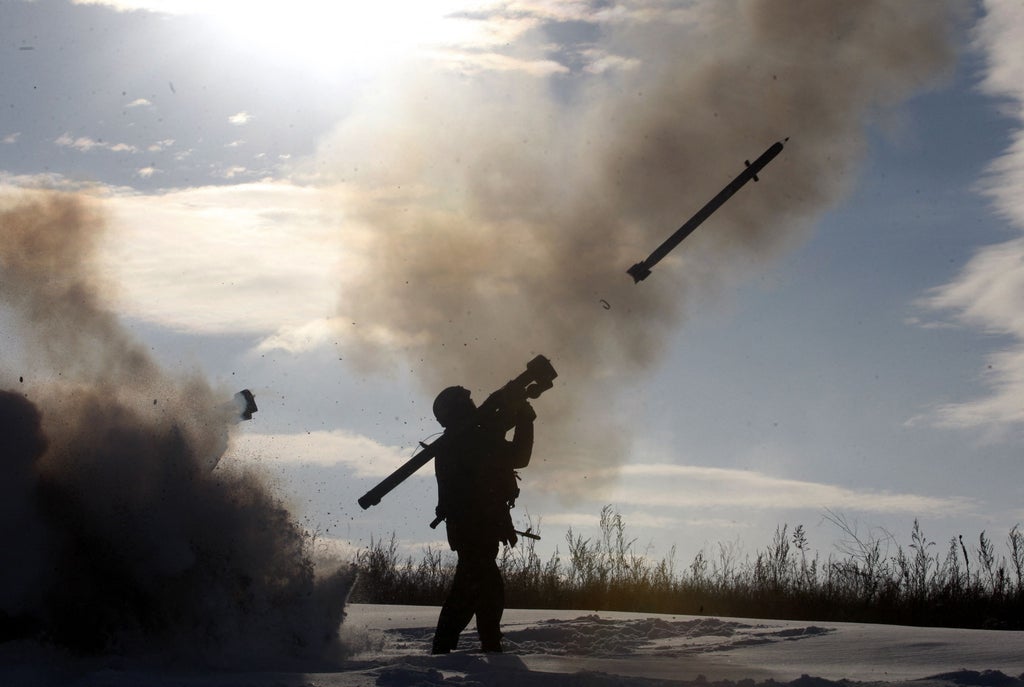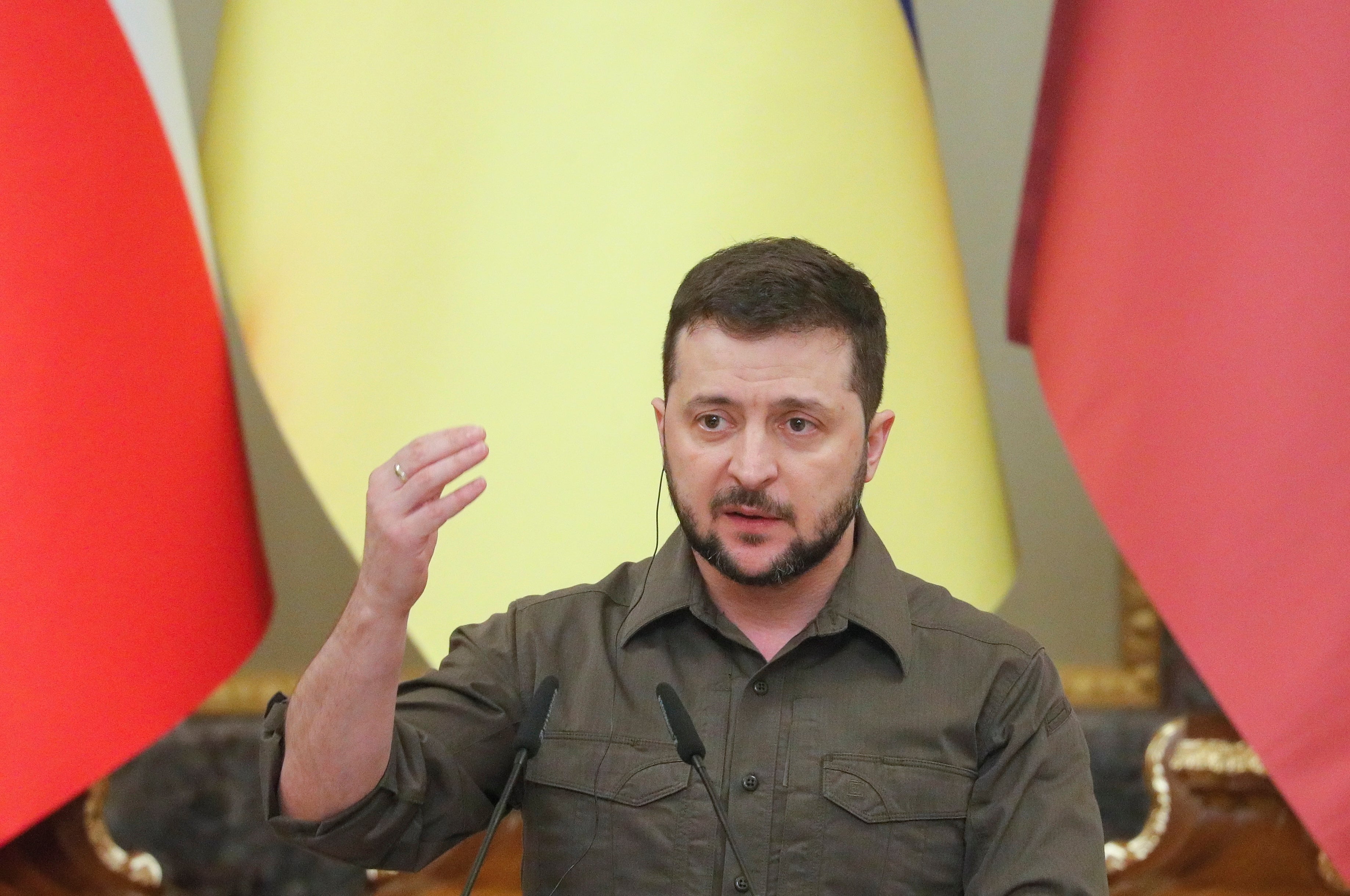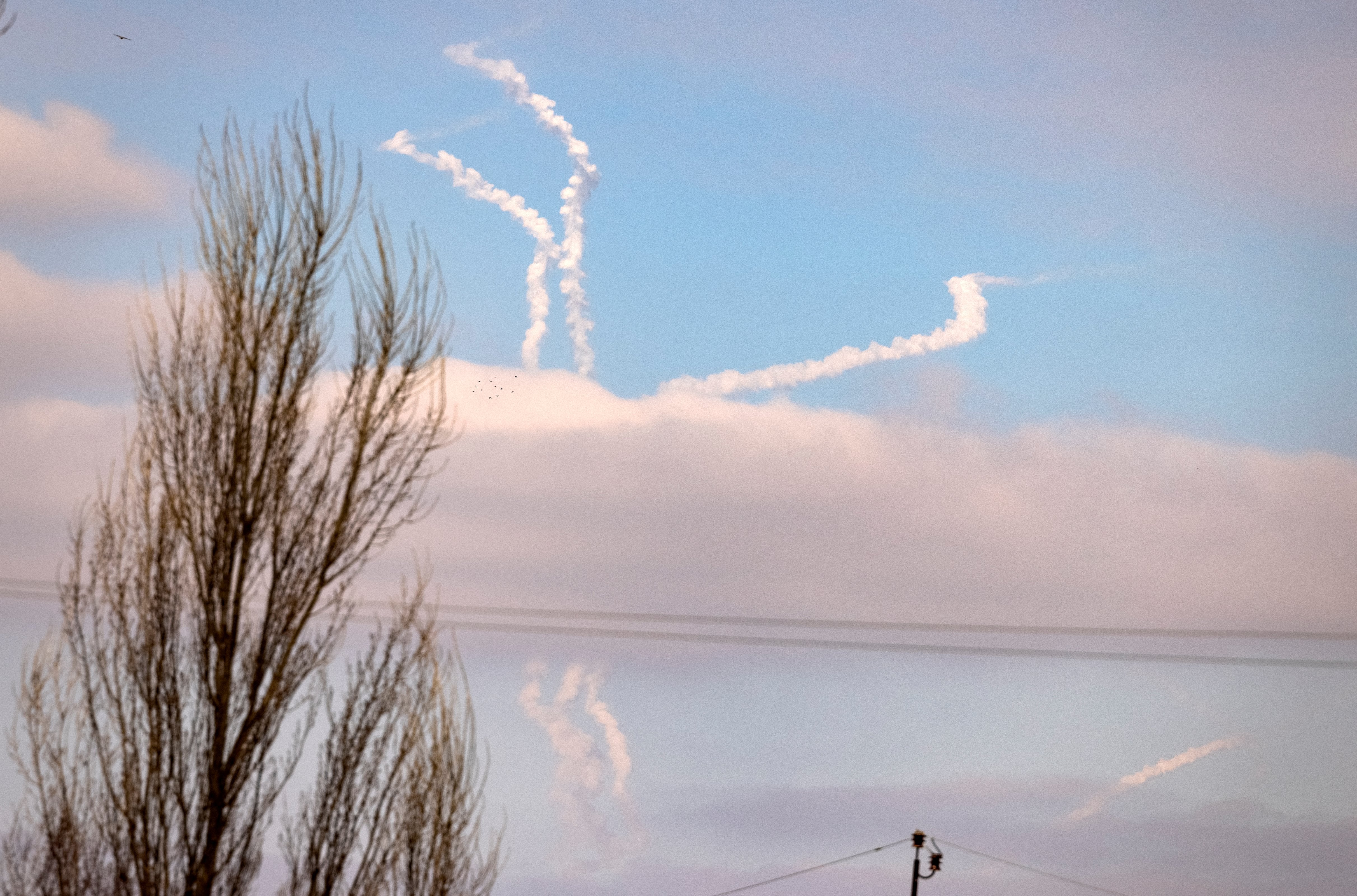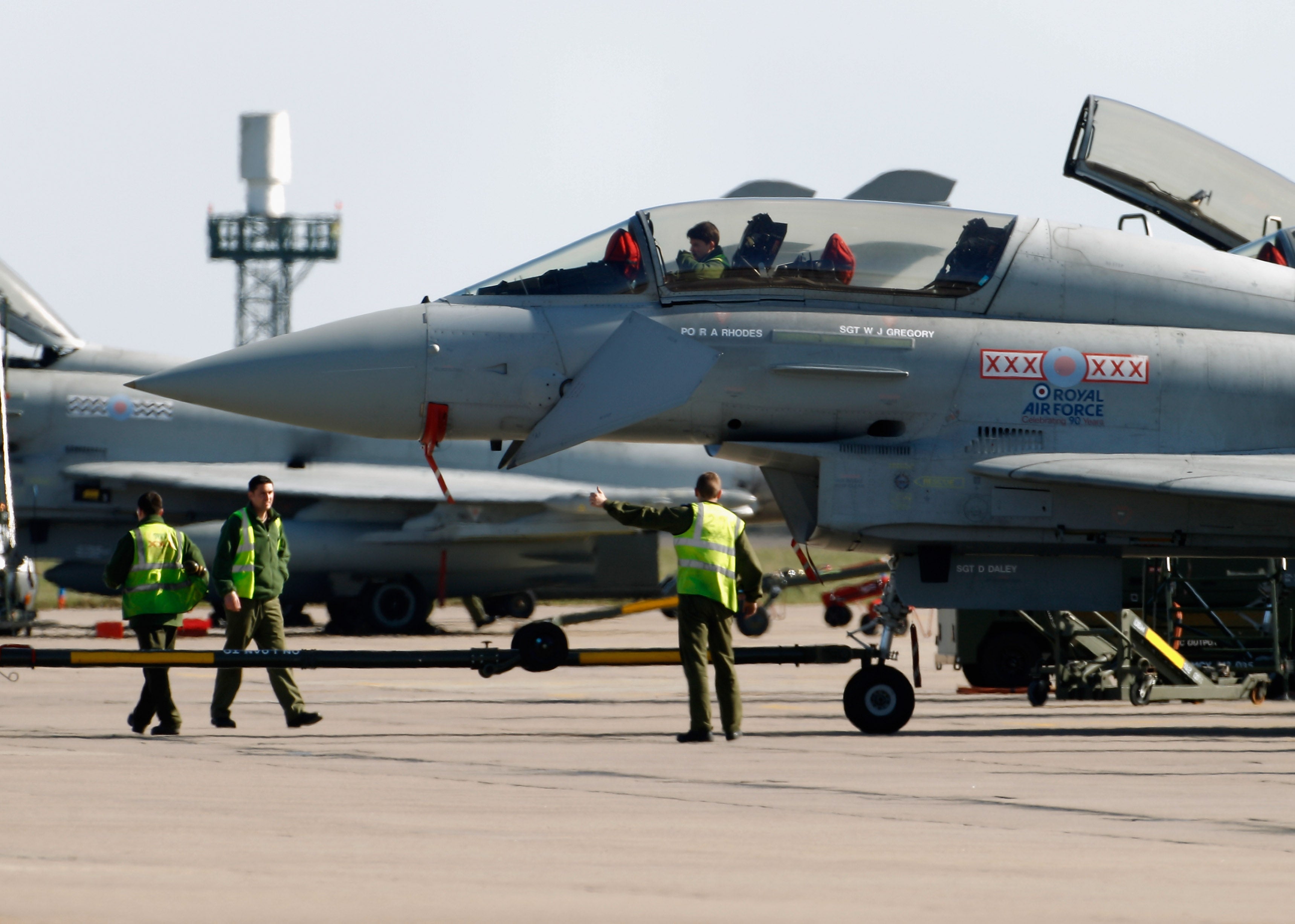
Western arms manufacturers are racing to cash in on the billions of dollars of sales in a “gold rush” created by Russia’s invasion of Ukraine, and the likely increased militarisation of Europe that will follow, say industry experts.
Already, the US and other western nations are providing large sums to help Ukraine defend itself in the short term, and making it easier to obtain weapons such as Stinger, Javelin and Stormer missile systems.
Companies such as Raytheon Technologies have seen their share price increase by up to 15 per cent in the last six months, as it and other giant arms makers attend classified meetings with the Pentagon to assess how they can benefit from the wish of Ukraine and its charismatic president, Volodymyr Zelensky, to arm itself against the Russian invasion.
In Britain, the Ministry of Defence recently hosted a visit for Ukrainian officials and arranged for them to travel to the military testing site at Salisbury Plain, to see the Stormer missile in action.
Yet the experts say while those initial sales represent only modest opportunities for the arms firms, it is the prospect of an increasingly militarised Europe in the years and decades ahead, where the true bonanza will lie. This is something top officials at arms manufacturers are already talking about when they address shareholders and the business media.
Nations, including Germany, fundamentally pacifistic since the end of the Second World War, are now seeking to reshape their entire military in the wake of Russia’s actions.
Germany has already placed an order for 35 F-35 fighters, the world’s most modern combat aircraft, from US manufacturer Lockheed Martin.
The move came after German chancellor Olaf Scholz said Berlin would increase its military expenditure by a one-off payment of $113bn, and commit to devoting 2 per cent of its annual budget on arms expenditure.
“In attacking Ukraine, Putin does not just want to eradicate a country from the world map, he is destroying the European security structure,” Scholz told German legislators in February, in what represented the biggest shift in its foreign policy for 70 years.
William Hartung, an expert on the international arms trade, tells The Independent these opportunities represent a “gold rush” for the industry.
“They’re standing to profit in so many ways,” Hartung says.
“The [Biden] administration has spent about $3.2bn in arms aid to Ukraine, and although a lot of that is from current stocks, all of its going to be replenished. through contracts from the Pentagon. They also may replace some of the weapons supplied by the allies.”
He adds: “And then, as Europe start spending more, the US companies will benefit from that.”
Hartung, author of Prophets of War: Lockheed Martin and the Making of the Military-Industrial Complex and a senior research fellow at the Quincy Institute for Responsible Statecraft, says prior to the invasion weapons makers were already anticipating a profitable year.
Yet, Putin’s decision to invade Ukraine and scare some Nato and other European countries into thinking that they could be his next target, has delivered huge momentum to the industry.
While individual companies have done well as a result of this, the entire sector has benefited; in the US, the S&P’s Aerospace and Defence fund has seen an increase of at least 11 per cent.

In an article written by Hartung and Julia Gledhill, an analyst at the Center for Defense Information at the Project On Government Oversight, a Washington DC-based watchdog group, and published by Common Dreams, the pair quoted Gregory Hayes, CEO and chairman of Raytheon Technologies, as “bragging” about the profits his firm was set to make as a result of the conflict.
“We don’t apologise for making these systems, making these weapons. The fact is, they are incredibly effective in deterring and dealing with the threat that the Ukrainians are seeing today,” Hayes told the Harvard Business Review, one month after the invasion.
“I think again recognising we are there to defend democracy, and the fact is eventually we will see some benefit in the business over time.”
Hartung tells The Independent that many arms dealers seek to wrap themselves in ideas of democracy when pitching their products. Yet, he says most are utterly transactional and happy to sell arms to authoritarian regimes such as Saudi Arabia and Nigeria.
Last week, the Pentagon played down a classified meeting between the top officials at eight major arms manufacturers – Boeing Defense, Space & Security, L3Harris Technologies, Raytheon Technologies, BAE Systems, Lockheed Martin Corporation, Huntington Ingalls Industries, General Dynamics and Northrop Grumman.
Defence department spokesman John Kirby told reporters it was “part of a normal, scheduled, routine conversation”. But the meeting involved the CEOs of the companies and the talks were classified.
Asked about what was discussed, the Pentagon sent The Independent a statement that said the meeting had been chaired by deputy secretary of defense Dr Kathleen Hicks, who told the CEOs “the Biden Administration is working around the clock to fulfill Ukraine’s priority security assistance requests, drawing down weapons from US stocks when they are available, purchasing directly from industry for rapid delivery to Ukraine, and facilitating the transfer of weapons from Allies and partners when their systems better suit Ukraine’s needs”.

In March, the Biden administration proposed a 2023 Pentagon budget of $813bn, a 4 per cent increase of $31bn, from the 2022 spending package the president signed into law that month. It is likely Congress will add to that figure, as it did in 2022.
The British government has also been holding meetings with defence industry officials, and hosted representatives from Ukraine for a display of the purported prowess of the armoured missile launchers known as Stormers, and produced by BAE Systems Platforms and Services.
A spokesperson for the UK’s Ministry of Defence confirmed the weapons had been shown off during the visit of the Ukrainian officials. Britain has now reportedly agreed to send the weapons to Ukraine.
“During the visit, the British Army’s 3rd Division and Royal Marines demonstrated a range of equipment and options for further military support, including defensive missile systems and protected mobility vehicles,” the MOD said.
This would not be the first time the UK government has used an actual conflict as an opportunity to showcase British-made arms.
In 2011, when Britain, as part of a four-nation consortium behind the Eurofighter Typhoon, was trying to close a deal with India worth $11bn for 126 planes, it hosted Indian journalists at events at places such as RAF Fairford in southern England.

They told the reporters the Eurofighters had “outdone” France’s Dassault Aviation Rafale in sorties against the forces of former Libyan dictator Muammar Gaddafi. In the end, India bought the planes from France.
Asked about sales to Ukraine, a spokesperson for BAE Systems said the company “did not comment on customer operations”.
Asked about the claim that the industry was cashing in on a “gold rush”, the spokesperson rejected the assessment and said: “We continue to work closely with our government customers to understand and support their requirements.”
Raytheon Technologies did not respond to inquiries.
A spokesperson for Lockheed Martin cited recent public comments from CEO Jim Taiclet who said the “world has clearly changed with Russia’s invasion of Ukraine”.
“A major global power crossed a recognised international border to take territory by force and as a result, the value of strong deterrence to war as an instrument of nation’s geopolitical strategy has not been as great since the middle of the 20th century,” he said.
“So here at Lockheed Martin, we’re aggressively and have been aggressively positioning our company as a deterrence company using the F-35, and our other core platforms, as pathfinders.”

The invasion of Ukraine by Russia has severely complicated and made more difficult the job of those arguing for diplomatic solutions to such conflicts.
In March the UK-based Campaign Against the Arms Trade (CAAT) issued a statement denouncing Russia’s invasion of Ukraine and saying it appeared to have committed war crimes.
“However, we reject the calls for increased militarisation of Europe in response. Militarism has created this crisis and further militarism is not the solution,” it added.
“European Nato members already spend almost five times as much as Russia on their militaries, and Russian military power has been shown to fall far short of what many believed.”
CAAT research coordinator Samuel Perlo-Freeman tells The Independent his group does not “want to see a return to Europe of opposing armed camps”.
“The west is still overwhelmingly more powerful militarily than Russia. We need to look at ways of de-escalating that situation. With Putin in power that is not an easy question,” he says.
“But the longer we have this heightened state of alert, increased militarisation, with Russia seeing a much more powerful west on its doorstep, and Nato and the west seeing an extremely aggressive and militaristic Russia, that’s not a good recipe for how things could turn.”
He says while his group is appalled by the atrocities in Ukraine, “we do need to be thinking in the long term about how this situation can be deescalated, how we can work for mutual demilitarisation” once the current situation ends.
He adds: “We need to rebuild the lines of communication that existed in the Cold War where there were absolutely opposed ideological systems, and a much more powerful Soviet Union than Russia is now.”







